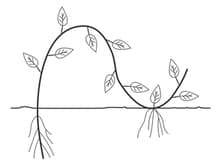HARD
NEET
IMPORTANT
Earn 100
Following table summarises the comparisons between phylloclades and cladodes (cladophylls).
Phylloclade
Cladode
(i)
Both main stem and branches are modified to function like leaves
Only the branches are modified to take over the function of leaves
(ii)
Phylloclade has limited or definite growth
Cladode has unlimited or indefinite growth
(iii)
It consists of several nodes and internodes
It is usually one inter-node long
(iv)
True leaves are commonly caducous
True leaves are either reduced to scales or modified to spines
(v)
Examples: , etc
Examples: , etc
Pick up the wrong differences and select the correct option.
Phylloclade
Cladode
(a) and
(b) and
(c) and
(d) and
25% studentsanswered this correctly

Important Questions on Morphology of Flowering Plants
EASY
NEET
IMPORTANT
With respect to the given figure, select the correct option.

EASY
NEET
IMPORTANT
Match column with and select the correct option from the given codes.
| I | II | ||
|---|---|---|---|
| (a) | Thorns | (i) | Vegetative propagation |
| (b) | Phylloclades | (ii) | Defensive mechanism |
| (c) | Runners | (iii) | Mechanical support |
| (d) | Stilt roots | (iv) | Absorption of nutrition |
| (e) | Haustoria | (v) | Photosynthesis |
EASY
NEET
IMPORTANT
_________ are one internode long runners, usually found in rosette plants at the ground/water level.
EASY
NEET
IMPORTANT
Select the mismatched pair out of the following.
EASY
NEET
IMPORTANT
In some _______, the leaf base may become swollen and is called as _______.
EASY
NEET
IMPORTANT
Which of the following represents the functions of veins in the leaves?
MEDIUM
NEET
IMPORTANT
Reticulate venation is a characteristic of dicots. An exception to this generalization is
EASY
NEET
IMPORTANT
Parallel venation is a characteristic of monocots. Which of the following is an exception to this generalisation?
